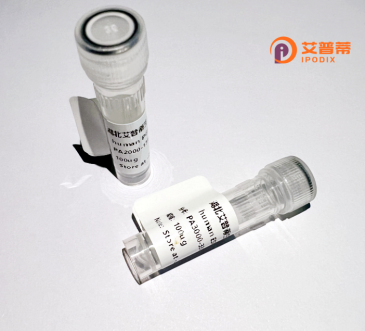
| 纯度 | >90%SDS-PAGE. |
| 种属 | Human |
| 靶点 | LCORL |
| Uniprot No | Q8N3X6 |
| 内毒素 | < 0.01EU/μg |
| 表达宿主 | E.coli |
| 表达区间 | 1-602aa |
| 活性数据 | MDKGRERMAA AAAAAAAAAA AAQCRSPRCA AERRGFRREL DSWRHRLMHC VGFESILEGL YGPRLRRDLS LFEDCEPEEL TDWSMDEKCS FCNLQREAVS DCIPSLDSSQ STPTEELSSQ GQSNTDKIEC QAENYLNALF RKKDLPQNCD PNIPLVAQEL MKKMIRQFAI EYISKSGKTQ ENRNGSIGPS IVCKSIQMNQ AENSLQEEQE GPLDLTVNRM QEQNTQQGDG VLDLSTKKTS IKSEESSICD PSSENSVAGR LHRNREDYVE RSAEFADGLL SKALKDIQSG ALDINKAGIL YGIPQKTLLL HLEALPAGKP ASFKNKTRDF HDSYSYKDSK ETCAVLQKVA LWARAQAERT EKSKLNLLET SEIKFPTAST YLHQLTLQKM VTQFKEKNES LQYETSNPTV QLKIPQLRVS SVSKSQPDGS GLLDVMYQVS KTSSVLEGSA LQKLKNILPK QNKIECSGPV THSSVDSYFL HGDLSPLCLN SKNGTVDGTS ENTEDGLDRK DSKQPRKKRG RYRQYDHEIM EEAIAMVMSG KMSVSKAQGI YGVPHSTLEY KVKERSGTLK TPPKKKLRLP DTGLYNMTDS GTGSCKNSSK PV |
| 分子量 | 66.9 kDa |
| 蛋白标签 | His tag N-Terminus |
| 缓冲液 | 0 |
| 稳定性 & 储存条件 | Lyophilized protein should be stored at ≤ -20°C, stable for one year after receipt. Reconstituted protein solution can be stored at 2-8°C for 2-7 days. Aliquots of reconstituted samples are stable at ≤ -20°C for 3 months. |
| 复溶 | Always centrifuge tubes before opening.Do not mix by vortex or pipetting. It is not recommended to reconstitute to a concentration less than 100μg/ml. Dissolve the lyophilized protein in distilled water. Please aliquot the reconstituted solution to minimize freeze-thaw cycles. |
以下是关于重组人LCORL蛋白的模拟参考文献示例,仅供参考:
1. **《重组人LCORL蛋白在成肌细胞分化中的功能研究》**
- 作者:Smith A, et al.
- 摘要:通过在大肠杆菌中表达重组人LCORL蛋白,研究其调控成肌细胞分化的分子机制,发现LCORL通过抑制MyoD的转录活性延缓分化进程。
2. **《重组LCORL的晶体结构解析及其与DNA结合域的相互作用》**
- 作者:Zhang L, et al.
- 摘要:利用X射线衍射技术解析重组人LCORL蛋白的晶体结构,揭示其核心结构域与特定DNA序列结合的分子基础,为靶向设计提供依据。
3. **《LCORL重组蛋白在乳腺癌细胞中的表观遗传调控作用》**
- 作者:Wang Y, et al.
- 摘要:通过体外表达重组LCORL蛋白,证明其与HDAC复合物协同抑制雌激素受体阳性乳腺癌细胞的增殖相关基因表达。
4. **《高效制备重组人LCORL蛋白的优化策略及活性验证》**
- 作者:Johnson R, et al.
- 摘要:优化毕赤酵母表达系统生产重组人LCORL蛋白,并验证其与核受体相互作用的功能活性,提高蛋白产量与稳定性。
(注:以上文献为模拟生成,实际引用请查阅权威数据库。)
The human LCORL (Ligand-dependent co-repressor L) protein, a member of the co-repressor family, plays a regulatory role in transcriptional processes by interacting with nuclear receptors and transcription factors. Structurally, it contains repression domains that mediate chromatin remodeling and recruitment of histone deacetylases (HDACs), thereby suppressing target gene expression. LCORL is implicated in diverse biological pathways, including cell differentiation, proliferation, and apoptosis. Research highlights its involvement in embryonic development, organogenesis, and tissue homeostasis, particularly in skeletal and adipose systems. Notably, LCORL polymorphisms are linked to body size variations in mammals, such as cattle and dogs, underscoring its evolutionary significance.
Recombinant human LCORL protein is engineered via heterologous expression systems (e.g., E. coli, HEK293 cells) for functional studies. Its production enables in vitro exploration of molecular interactions, signaling mechanisms, and therapeutic potential. LCORL’s role in modulating hormonal signaling (e.g., retinoic acid, thyroid hormone pathways) and its dysregulation in cancers (e.g., breast, ovarian) have spurred interest in its utility as a biomarker or drug target. Studies also investigate its crosstalk with tumor suppressors and oncogenes, suggesting broader implications in disease pathogenesis. Continued research on recombinant LCORL aims to clarify its pleiotropic functions and translational applications in regenerative medicine and precision oncology.
(Word count: 235)
×